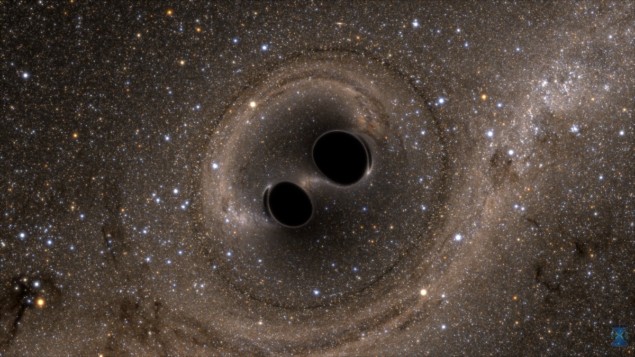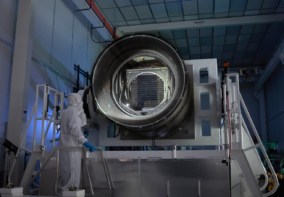
A statistical solution to the infamous three-body problem of classical physics could explain why the LIGO-Virgo gravitational-wave detectors have observed numerous black-hole mergers.
The three-body problem involves three classical objects (such as stars, planets or even black holes) orbiting and interacting with one another. In principle, the behaviour of a three-body system at a future time in its evolution is uniquely determined by the initial conditions of the system. However, infinitesimal changes in these initial conditions can accumulate over time to become huge differences in outcomes. As it is never possible to measure initial conditions with infinite precision, it is therefore never possible to use them to predict long-term outcomes – a signature of deterministic chaos.
A general closed-form solution of the three-body problem does not exist, but if the objects are very different in mass, the system can be approximated by two-body problems with small perturbations from the third object. Things become more daunting, however, when the three masses are similar. Now, astrophysicists in the US have built computer models of such “non-hierarchical” triple systems. Created by Nicholas Stone of the Hebrew University of Jerusalem (who did the work while at Columbia University in New York) and Nathan Leigh of University of Concepción in Chile, the simulations could help to explain why LIGO-Virgo have seen an abundance of gravitational-wave signals from merging black holes.
Breaking up is easy to do
Researchers know that non-hierarchical three-body systems are not stable in the long term and tend to break apart. “Non-hierarchical triples tend to break up not very long after they’re born,” explains Stone. “That means the non-hierarchical triples out there now in the universe doing interesting things were formed in some special way.”
Stone and Leigh modelled one of two known mechanisms by which such a non-hierarchical triple system can form. “If you have a very dense star cluster, individual binaries will frequently scatter off single stars that pass by,” explains Stone. “If a single star comes close enough it can temporarily capture into the binary and make an unstable, non-hierarchical triple, which later disintegrates to leave a binary with different properties.”
The researchers ran several hundred thousand computer simulations of such events. After the third body is captured, the three-body system evolves through a series of long periods of time in which two stars effectively behave as a binary, while the third star interacts weakly from a distance. These periods of calm are interrupted by relatively brief, intensely chaotic “scrambles” when the three stars are all close together. Each scramble ends when one star – not necessarily the same star as before – gains enough energy to escape the centre of the system. This allows the other two to return to a relatively stable near-binary orbit. The energy is insufficient for the ejected star to truly escape the three-body system, however, and when it returns another scramble occurs. When one of the three stars does acquire escape velocity during a scramble, the three-body system breaks up, leaving behind the new binary.
Giving birth to binaries
Although it remains impossible to predict how a specific system will evolve, the new research presents a statistical distribution showing the probabilities of a how chaotic non-hierarchical triple systems are most likely to break up. Moreover, it allows astronomers to draw inferences about the probable conditions in triple systems that gave birth to binaries with specific properties. “We can tell you that the orbits are generally elliptical rather than circular, with some probability distribution of ellipticities,” explains Stone.
“I think the results are very significant from a theoretical astrophysics point of view, but they have a more general application beyond this small group,” explains Adrian Hamers of the Max Planck Institute for Astrophysics in Munich. In particular, the creation of certain types of binary systems could explain why the LIGO–Virgo gravitational-wave detectors have observed several mergers of solar-mass black holes in binary systems.
Such a black-hole binary could be produced by an isolated pair of stars each collapsing to form a black hole. The problem with this, however, is that stars of the appropriate masses and separation to create such a black-hole binary are expected to merge as stars long before they become black holes. If the stars are further apart – and therefore have enough time to collapse to form black holes –then the black holes are expected to take longer than the age of the universe to merge.

LIGO detects first ever gravitational waves – from two merging black holes
The presence of a third body could be the answer as Hamers explains: “In these types of dynamical interactions, you can drive black holes into tighter orbits where they can merge within much shorter times.
Johan Samsing of the Niels Bohr Institute in Copenhagen sees several important implications for the work – and one key shortcoming: the formulas work only for systems evolving chaotically through a series of scramble states, forgetting their initial conditions. At present, he says, a computer simulation is needed to calculate whether the system will enter such a state: “In about half of all interactions, the third object will promptly go through the binary and perturb it in a single passage,” he explains. “I would see this as a first step: if they can expand on their formalism and say which parts of phase space are chaotic and which are not, that would be a natural next step.”
The research is described in Nature.



